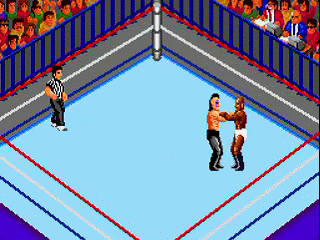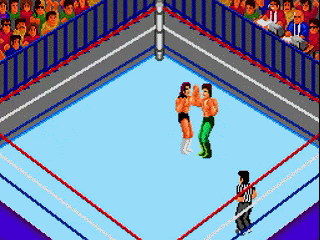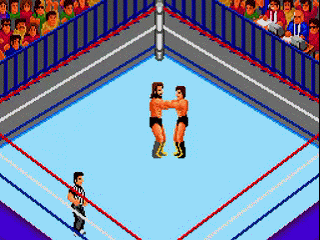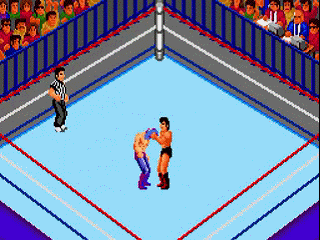
|
||||
|---|---|---|---|---|
|
Fire Pro Wrestling: Combination Tag
A Puroresu Game Review by Kevin Wilson Platform: PC Engine/TurboGrafx-16 Graphics: For a game that came out 26 years ago, it doesn't look too bad. A lot of the Japanese wrestlers looked similar since they used the same model, but if the wrestler had any special identifying traits they were easy distinguishable. Most of the moves looked solid, the suplexes were missing a few animation frames which happens with older games but overall I don't think the graphics held the game back. There was also an issue with hit detection which I guess is a graphics issue since it would look like you hit the wrestler but you'd just whiff. Not bad for the time period though, this was about as good as it got pre-SNES.
Controls: The controls were pretty straight forward: three levels of strikes (a staple of early Fire Pro games), grapples, and top rope moves were all here. For grapples each wrestler had five from the front and three from the back, and one ground submission move. Also, some wrestlers could do a tope suicida and all wrestlers had two top turnbuckle moves. Compared to other wrestling games from the time period this was impressive as it wasn't normal to have eight different grapple moves per wrestler. The only thing missing was a 'special' or finisher move, generally if the wrestler had a finisher it was just the strong grapple but not all the strong grapple moves were finishers. There of course was a run button but it was pretty useless since back then there wasn't free running, you had to run the ropes in a certain way and it was difficult to make it do exactly what you wanted it to do. For grapples, it was timing based similar to all future Fire Pro games. It was always smart to start with weak grapples as the harder grapples would be reversed by default until the opponent was weakened. I had some success actually winning matches so the timing seemed pretty consistent. I did have an issue however breaking out of submission holds, while the computer kicked out of them pretty quickly sometimes I'd be in a hold for 20 seconds or more. But aside from the run options and breaking out of submissions, the game played pretty well. Gameplay Options: Fire Pro Wrestling: Combination Tag had three different modes: single player, tag team, and elimination tag. You can play any of them as single player or with a friend, but you can not have COM vs. COM matches. For the single and tag modes, you play a series of matches until you beat everyone. Once you do that, you get a code and have to run through all the matches again. Once you do that (!!!) then you get to fight against the bosses, first Lou Thesz and then Karl Gotch. This may seem like a lot of work but you have to remember back in the day, with limited game modes they had to give you a reason to keep playing the game over and over. Think of it like NG+ in current games, it was just a way for Human to encourage you to play it again. For the Elimination Tag, which was unique at the time, it was as it sounds and a fun little side match type to mix things up.
Wrestlers Available: This game had a very large roster for a game at the time, as 16 wrestlers were included. They were also all paired together, so when you played the tag team mode you always went against the same pairings. The tag teams included were Inoki and Maeda, Tsuruta and Tenryu, Choshu and Saito, The Gaspers, Hansen and Brody, Mascaras and Caras, Bad News Allen and Tiger Jeet Singh, and the Road Warriors. The wrestlers included were from New Japan, All Japan, and UWF, and of course all had different names since the game wasn't licensed by any of those promotions. Really solid line-up with the best from each promotion. Historical Significance: The historical significance of this game almost goes without saying but I will say something anyway. 16 wrestlers was a lot back then (for example, Champion Pro Wrestling came out on the console in 1990 and had nine wrestlers), but more importantly it introduced a new grapple system. The 'knee dip' for grapple timing became a staple for Fire Pro games for the next 20 years, and at the time this was about the best you were going to get. Anytime a series has 28 games you have to respect the first, as without the first there wouldn't have been the opportunity for 27 more to follow. Overall Thoughts: As a stand alone game, Fire Pro Wrestling: Combination Tag feels about as old as it is. The graphics obviously look like what I was used to growing up with the Nintendo and the hit detection does hurt it a bit. The timing based grapple can be frustrating as you can be sure you hit it at the right time but the computer does a move, and you don't know if you missed the timing or if the computer just felt like winning that one. But that is an issue in all Fire Pro games, any time you are doing something timing based against the COM there will always be a degree of luck and randomness. Also it should be pointed out that even though each wrestler had eight grapple moves, a lot of the moves were shared between many wrestlers with some move sets being almost identical, which does hurt the replay value. I enjoyed it during the time I played it though, especially when I was wrestlers you don't see very often such as The Gaspers or Bad News Allen. For historical purposes, this is a game that must be recognized but not a game one needs to run out and play. Back to Puroresu Game Reviews |
||||
|



